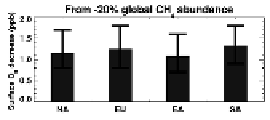Environmental Engineering Reference
In-Depth Information
is not currently regulated for air quality, its contribution to surface O
3
, along with
that from foreign (and natural) emissions of the other O
3
precursors, is typically
considered part of the “background”. While combined reductions of NO
x
, NMVOC,
and CO within a region are more effective than equivalent percentage reductions
of CH
4
at decreasing surface O
3
within that same region, “background” surface O
3
responds roughly equivalently to foreign anthropogenic emission reductions of
Fig. 1.
Decrease in surface
O
3
(ppb) resulting from a 20% decrease in global CH
4
abundances
(from 1,760 to 1,408 ppb) in 18 global or hemispheric chemical transport models over
continental-scale source regions: North America (NA; 15-55°N, 60-125°W), Europe (EU; 25-
65°N; 10°W-50°E), East Asia (EA; 15-50 N; 95-160°E) and South Asia (SA; 5-35°N; 50-
95°E) (Fiore et al., 2009). Model ensemble mean (blue) and range across individual models
(black lines) are shown
°
Fig. 2.
Model ensemble surface O
3
decrease (ppb), annually and spatially averaged over the
regions in Fig. 1 from 20% decreases in anthropogenic emissions of NO
x
+ CO + NMVOC (red)
versus 20% decreases in anthropogenic CH
4
(blue). Influence of each source region on surface
O
3
within the same region (termed “domestic”; left panel). Sum of the O
3
responses to emission
changes within the three foreign source regions; these components are generally considered to be
The availability of low-cost options suggests that CH
4
emission controls are
feasible for jointly addressing climate and O
3
air quality goals (West and Fiore,
2005). Full-chemistry transient simulations (2005-2030) in the GFDL MOZART-
2 global tropospheric chemistry model indicate that cost-effective CH
4
controls (at
a marginal cost of ~$15/t CO
2
equivalent) would offset the positive climate forcing
from CH
4
and O
3
that would otherwise occur from increases in NO
x
and CH
4
emissions in the baseline CLE (Current Legislation) scenario (
Fig. 3a
; Fiore et al.,
2008). Cost-effective controls (scenario B in
Fig. 3)
are sufficient to decrease the
incidence of O
3
events above 70 ppb in the model to below the number of occur-
rences in 2005 over Europe in summer; over the United States, only the simulation
where CH
4
is set to pre-industrial levels (CH
4
-700) achieves this result, reflecting
differences in regional projections for NO
x
emissions under the baseline scenario
relative to the 2030 CLE baseline scenario.


